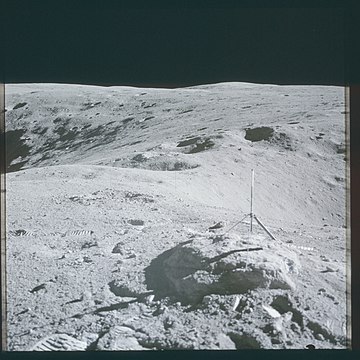 Apollo 16 image, with Flag left of center and Spook right of center. Plum is the tiny crater on the southeast rim of Flag. | |
| Coordinates | 8°58′S 15°27′E / 8.97°S 15.45°E |
|---|---|
| Diameter | 240 m[1] |
| Eponym | Astronaut-named feature |
Flag crater is a small crater in the Descartes Highlands of the Moon visited by the astronauts of Apollo 16. The name of the crater was formally adopted by the IAU in 1973.[1] Geology Station 1 is adjacent to Flag, at the much smaller Plum crater.
On April 21, 1972, the Apollo 16 Apollo Lunar Module (LM) Orion landed about 1.5 km east of Flag, which is between the prominent North Ray and South Ray craters. The astronauts John Young and Charles Duke explored the area over the course of three EVAs using a Lunar Roving Vehicle, or rover. They drove to Flag on EVA 1.



Flag crater is approximately 240 m in diameter and over 20 m deep.[2] The adjacent crater Plum is only about 30 m in diameter.[3] The slightly larger crater Spook, also visited by the astronauts, lies less than 1 km to the east.
Flag cuts into the Cayley Formation of Imbrian age.[4]
-
TV camera still of Duke (left) and Young on the rim of Plum. Duke remarked at this time, "John, you are just beautiful. That is the most beautiful sight." Young is standing next to a boulder from which sample 61295 was taken.
-
Young took this photo of Duke with Plum and the rover in the background from where he is standing in the above TV still.
-
The ridge between Flag (left) and Plum (right)
- ^ a b Flag, Gazetteer of Planetary Nomenclature, International Astronomical Union (IAU) Working Group for Planetary System Nomenclature (WGPSN)
- ^ Apollo 16 Landing Area, 78D2S1(50), NASA Lunar Topophotomap. Published by The Defense Mapping Agency, November 1974. Available from Lunar and Planetary Institute.
- ^ Plum, Gazetteer of Planetary Nomenclature, International Astronomical Union (IAU) Working Group for Planetary System Nomenclature (WGPSN)
- ^ Geologic Map of the Apollo 16 (Descartes) Landing Area Archived 2019-07-21 at the Wayback Machine by Apollo Field Geology Investigation Team (D. P. Elston, E. L. Boudette, J. P. Schafer), United States Geological Survey, April 1972


